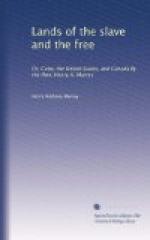I now propose to give a slight sketch of his farm, so as to convey, to those interested, an idea of the general system of agriculture adopted in the Northern States; and if the reader think the subject dull, a turn of the leaf will prove a simple remedy.
The extent farmed is 2000 acres, of which 400 are in wood, 400 in meadow, 400 under plough, and 800 in pasture. On the wheat lands, summer fallow, wheat, and clover pasture, form the three years’ rotation. In summer fallow, the clover is sometimes ploughed in, and sometimes fed off, according to the wants of the soil and the farm. Alluvial lands are cultivated in Indian corn from five to ten years successively, and then laid down in grass indeterminately from three to forty years. Wheat—sometimes broadcast, sometimes drilled—is put in as near as possible the 1st of September, and cut from the 10th to the 20th of July. Clover-seed is sown during March in wheat, and left till the following year. Wheat stubble is pastured slightly; the clover, if mowed, is cut in the middle of June; if pastured, the cattle are turned in about the 1st of May.
Pumpkins are raised with the Indian corn, and hogs fattened on them; during the summer they are turned into clover pasture. Indian corn and pumpkins are planted in May, and harvested in October; the leaf and stalk of the Indian corn are cut up for fodder, and very much liked. Oats and barley are not extensively cultivated.




